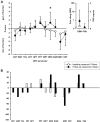Dynamic of the somatosensory system in postherpetic neuralgia
- PMID: 30706032
- PMCID: PMC6344136
- DOI: 10.1097/PR9.0000000000000668
Dynamic of the somatosensory system in postherpetic neuralgia
Abstract
Introduction: In postherpetic neuralgia (PHN) different types of patients can be distinguished regarding their predominant peripheral nociceptor function.
Objective: The aim was to examine somatosensory profiles in the course of disease with special regard to the different subtypes existing in PHN.
Methods: Twenty patients with PHN (7 men and 13 women, age 67 ± 9.6 years) were examined at baseline (disease duration 18.1 ± 26 months) and follow-up (31.6 ± 23.8 months later) with quantitative sensory testing (protocol of the German Research Network on Neuropathic Pain).
Results: Fourteen (70%) PHN patients presented with impaired (iPHN) and 6 (30%) with preserved (pPHN) C-fiber function. Groups did not differ regarding age, disease duration, or pain intensity at baseline. Both groups did not differ regarding change in pain intensity (-0.5 ± 2.3 vs -1.7 ± 2.6 numerical rating scale, P = n.s.) at follow-up. Impaired PHN improved in thermal and mechanical detection thresholds as well as allodynia independent from change in pain intensity. By contrast, pPHN showed an increase in mechanical pain sensitivity (1.4 ± 2.5 vs -0.4 ± 2.2, P < 0.05) and a trend towards a stronger loss of detection (66% vs 33%, P = n.s.) on follow-up.
Conclusion: Results demonstrate that patients with preserved C-fiber function are more predisposed to develop signs of central sensitization as demonstrated by an increased mechanical pain sensitivity. Impaired C-fiber function is able to improve even in chronic cases, but a functional loss is unlikely to play a role here. The knowledge of development of somatosensory profiles in the course of the disease offers possibilities to optimize a mechanism-based treatment.
Keywords: Chronic pain; Mechanism-based treatment; Postherpetic neuralgia; QST; Somatosensory profiles.
Conflict of interest statement
Sponsorships or competing interests that may be relevant to content are disclosed at the end of this article.
Figures


Similar articles
-
Heterogenous patterns of sensory dysfunction in postherpetic neuralgia suggest multiple pathophysiologic mechanisms.Anesthesiology. 2000 Mar;92(3):691-8. doi: 10.1097/00000542-200003000-00013. Anesthesiology. 2000. PMID: 10719948 Clinical Trial.
-
Somatosensory profiles in acute herpes zoster and predictors of postherpetic neuralgia.Pain. 2019 Apr;160(4):882-894. doi: 10.1097/j.pain.0000000000001467. Pain. 2019. PMID: 30585985 Clinical Trial.
-
Sensory symptom profiles differ between trigeminal and thoracolumbar postherpetic neuralgia.Pain Rep. 2018 Feb 6;3(1):e636. doi: 10.1097/PR9.0000000000000636. eCollection 2018 Jan. Pain Rep. 2018. PMID: 29430564 Free PMC article.
-
Postherpetic neuralgia: irritable nociceptors and deafferentation.Neurobiol Dis. 1998 Oct;5(4):209-27. doi: 10.1006/nbdi.1998.0204. Neurobiol Dis. 1998. PMID: 9848092 Review.
-
Treatment options in postherpetic neuralgia.Acta Neurol Scand Suppl. 1999;173:25-35; discussion 48-52. doi: 10.1111/j.1600-0404.1999.tb07387.x. Acta Neurol Scand Suppl. 1999. PMID: 10819089 Review.
Cited by
-
Comparison of the Severity of Zoster-Associated Pain and Incidence of Postherpetic Neuralgia in Patients with and without Pre-Existing Spinal Disorders at the Same Spinal Nerve Level: A Retrospective Multicenter Study.J Pers Med. 2023 Aug 22;13(9):1286. doi: 10.3390/jpm13091286. J Pers Med. 2023. PMID: 37763054 Free PMC article.
-
Application and Therapeutic Effect of Puncturing of the Costal Transverse Process for Pulsed Radiofrequency Treated T1-T3 Herpes Zoster Neuralgia.J Pain Res. 2020 Oct 7;13:2519-2527. doi: 10.2147/JPR.S266481. eCollection 2020. J Pain Res. 2020. PMID: 33116793 Free PMC article.
-
A Comparison of Short-Term Peripheral Nerve Stimulation and Pulsed Radiofrequency in the Treatment of Postherpetic Neuralgia.J Pain Res. 2024 Dec 31;17:4583-4590. doi: 10.2147/JPR.S493000. eCollection 2024. J Pain Res. 2024. PMID: 39764349 Free PMC article.
-
C-tactile touch perception in patients with chronic pain disorders.Pain Rep. 2021 Jun 30;6(2):e941. doi: 10.1097/PR9.0000000000000941. eCollection 2021 Jul-Aug. Pain Rep. 2021. PMID: 34235344 Free PMC article.
-
Subgrouping patients with zoster-associated pain according to sensory symptom profiles: A cluster analysis.Front Neurol. 2023 Feb 17;14:1137453. doi: 10.3389/fneur.2023.1137453. eCollection 2023. Front Neurol. 2023. PMID: 36873449 Free PMC article.
References
-
- Baron R. Mechanisms of disease: neuropathic pain—a clinical perspective. Nat Clin Pract Neurol 2006;2:95–106. - PubMed
-
- Baron R, Hans G, Dickenson AH. Peripheral input and its importance for central sensitization. Ann Neurol 2013;74:630–6. - PubMed
-
- Boogaard S, Heymans MW, de Vet HC, Peters ML, Loer SA, Zuurmond WW, Perez RS. Predictors of persistent neuropathic pain—a systematic review. Pain Physician 2015;18:433–57. - PubMed
-
- Chapman CR, Vierck CJ. The transition of acute postoperative pain to chronic pain: an integrative overview of research on mechanisms. J Pain 2017;18:359.e1–359.e38. - PubMed
-
- Demant DT, Lund K, Finnerup NB, Vollert J, Maier C, Segerdahl MS, Jensen TS, Sindrup SH. Pain relief with lidocaine 5% patch in localized peripheral neuropathic pain in relation to pain phenotype: a randomised, double-blind, and placebo-controlled, phenotype panel study. PAIN 2015;156:2234–44. - PubMed
LinkOut - more resources
Full Text Sources
Miscellaneous
